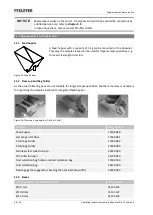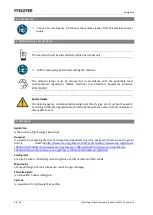
DIN ISO 9001 - Documentation
Revision 4 | Operating instructions sample cleaner SLN 4
39 | 40
15
DIN ISO 9001 - Documentation
In practical applications, the introduction of QM and TQM systems is becoming increasingly important.
Here you can find some points indicating how the accuracy of your test instrument can be documented.
Monitoring intervals for test instruments
It is recommended for the parameters stated below to be checked and documented once a year. Here is
a suggestion for a form that should make this task easier.
Checking the nominal hole widths:
A certified precision nozzle gage with a read-off accuracy of 1/100 mm is available for accurate
measurement of the nominal hole widths, see
chapter 11
for article number.
Tolerances for sieve plates:
Slot:
ISO 5223
Test sieves for cereals
Round hole: DIN ISO 3310-2 Test sieves – Technical requirements and testing –
Part 2: Test sieves of perforated metal plate
Test process
Figure 25: Diagram for selecting the hole widths to be tested
Select about 40 sieve holes (see diagram for 2.5 mm sieve with 29x11 holes, 44 selected).
Position the sieve plate vertically and clamp it in the clamping fixture.
Insert the measuring tip of the nozzle gage manually at an angle of 90° into the sieve hole (the gage
must be at right angles to the sieve). Advance it until you encounter resistance, but without applying
force, hold firmly at the top end, the vernier scale moves down.
Read off the result on the vernier directly in the inserted condition. Enter it in a test log (see master
copy in
chapter 15.1
).
NOTICE
The results can be falsified by removing the nozzle gage before reading off the result,
e. g. due to the measuring tip jamming or having a pushing force exerted on it!
The sieve should be discarded if the nominal hole with is outside the tolerance required in the
standard for more than 3 values. Please contact the manufacturer!
1 2 3 4 5 6 7 8 9 10 11 12 13 14 15 16 17 18 19 20 21 22 23 24 25 26 27 28 29
1
2
3
4
5
6
7
8
9
10
11


































